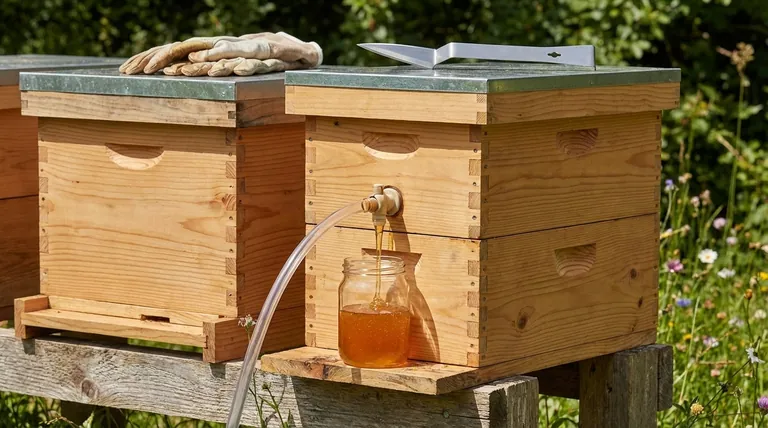In short, a beehive with a tap is known as a Flow Hive. This system uses specially designed frames that allow you to harvest honey directly from the hive without opening it, simply by turning a tool that functions like a tap. Honey flows out through a tube, leaving the bees and the comb largely undisturbed.
The Flow Hive represents a significant innovation focused on simplifying the honey extraction process. However, this convenience introduces specific trade-offs regarding cost, bee management practices, and the materials used within the hive, which every potential beekeeper must understand.

How a Flow Hive Works
To grasp the concept, it's useful to see the Flow Hive not as an entirely new invention, but as a major modification to the world's most popular hive design.
The Langstroth Foundation
Most modern beehives, including the Flow Hive, are based on the Langstroth design. This system consists of a stack of rectangular boxes, often called "supers," which hold a series of removable frames where bees build comb, raise brood, and store honey.
The Special Flow Frames
The key innovation of the Flow Hive is its proprietary Flow Frames. These are plastic frames containing partially formed honeycomb cells. The bees complete the cells with their own wax before filling them with honey and capping them, just as they would in a traditional frame.
The 'Tapping' Mechanism
Each Flow Frame features a split-cell system. When you insert and turn a special tool or "key" into the top of the frame, the cells vertically split and shift. This creates channels inside the comb, allowing the honey to flow downwards and out of the hive through a collection tube, all without harming the bees.
Understanding the Trade-offs
While the "honey on tap" concept is appealing, it's crucial to weigh the benefits against the potential drawbacks.
Benefit: Simplified Harvesting
The primary advantage is unprecedented ease of extraction. It eliminates the need to open the hive, smoke the bees, pull out heavy frames, and use expensive extraction equipment. This makes the process less stressful for both the beekeeper and the bees.
Drawback: Material and Bee Acceptance
Flow Frames are made of plastic. While durable and easy to clean, bees are sometimes slower to draw out and use plastic foundations compared to natural wax. Some beekeepers find their colonies are hesitant to fill the Flow Frames until all other space in the hive is utilized.
Drawback: Risk of Neglecting Hive Health
The convenience of not opening the hive for harvesting can create a pitfall for new beekeepers. It may lead them to neglect essential hive inspections. Regular checks for pests (like varroa mites), disease, and the health of the queen are critical for colony survival and are unrelated to honey harvesting.
Drawback: The Initial Cost
Flow Hives and individual Flow Frames are significantly more expensive than their traditional Langstroth counterparts. This initial investment can be a substantial barrier for those just starting in the hobby or looking to manage their budget carefully.
Making the Right Choice for Your Goal
Ultimately, the choice between a Flow Hive and a traditional hive depends entirely on your personal beekeeping objectives.
- If your primary focus is convenience and a unique harvesting experience: The Flow Hive is an excellent choice, provided you accept the higher cost and remain diligent about performing regular hive health inspections independent of harvesting.
- If your primary focus is learning traditional beekeeping skills on a budget: A standard Langstroth hive with wax or simple plastic frames offers a more affordable, time-tested path into the world of apiculture.
Choosing the right equipment is the first step in aligning your setup with your personal beekeeping philosophy.
Summary Table:
| Aspect | Flow Hive | Traditional Langstroth Hive |
|---|---|---|
| Harvesting Method | Honey flows out via a tap; minimal disturbance to bees. | Requires opening hive, removing frames, and using an extractor. |
| Primary Material | Plastic frames with pre-formed honeycomb cells. | Typically wood frames with wax or plastic foundation. |
| Key Benefit | Unprecedented convenience and ease of extraction. | Lower cost; teaches foundational beekeeping skills. |
| Key Drawback | Higher initial cost; risk of neglecting hive health inspections. | More labor-intensive harvesting process. |
Ready to equip your apiary with the right hive system?
Whether you're a commercial apiary seeking efficient honey harvesting solutions or a distributor looking for reliable beekeeping equipment, HONESTBEE has you covered. We supply high-quality beekeeping supplies and equipment through our wholesale-focused operations.
Contact HONESTBEE today to discuss how we can support your beekeeping success with the right tools for your goals.
Visual Guide

Related Products
- HONESTBEE Professional Long Handled Hive Tool with Precision Cutting Blade
- Professional 4 Frame Self Reversing Electric Honey Extractor for Beekeeping
- HONESTBEE 6 Frame Self Reversing Electric Honey Extractor for Beekeeping
- Electric 8 Frame Honey Spinner Extractor Equipment for Beekeeping
- Honey Gate Valve with Ergonomic Ball Handle Plastic Bee Honey Tap for Beekeeping Bottling and Honey Extractor Equipment
People Also Ask
- What are the features of a regular hive tool? The Essential Multi-Tool for Every Beekeeper
- What is a hive tool used for in beekeeping? Your Essential Guide to Hive Management
- How can a hive tool be used to remove propolis and burr comb? Master Hive Maintenance for a Healthy Colony
- What is the hive tool used for? The Essential Multi-Tool for Every Beekeeper
- How should beekeepers handle bees when using a hive tool? Master Calm, Deliberate Techniques



















